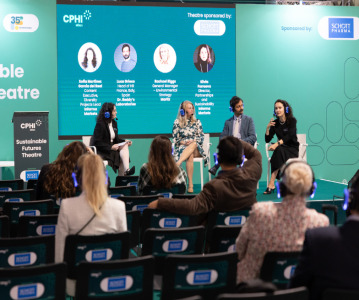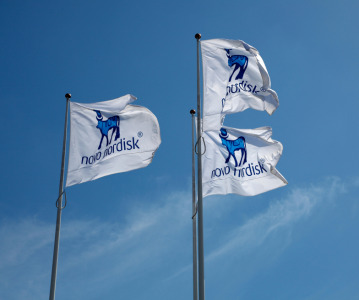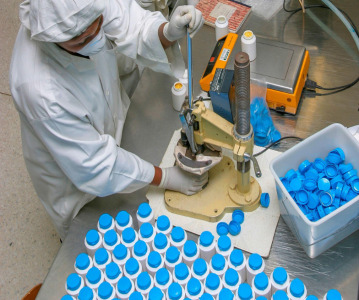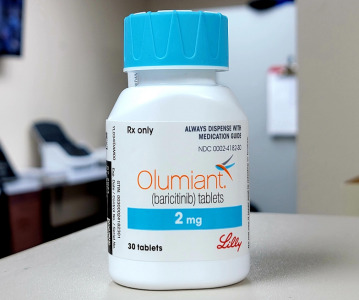Viral marketing for B2B pharma businesses: a CPHI Online case study

Discover how a Chinese chemical manufacturing company went viral on TikTok, and what their viral success means for the future of B2B digital marketing for the wider pharmaceutical industry and supply chain.
In late 2023/early 2024, Chinese chemical manufacturing company Shijiazhuang Donghua Jinlong posted several videos on short-form content platform TikTok. These videos feature sweeping shots of the manufacturer’s industrial buildings accompanied by AI voiceovers extolling their ‘industrial-grade glycine’, manufacturing certifications, and even a recent invitation to connect with them at this year’s CPHI & PMEC China 2024. Unexpectedly, the TikTok algorithm caused many of their videos to appear on the feeds of a distinctly non-pharmaceutical audience, prompting the creation of the Donghua Jinlong industrial-grade glycine meme.
Taking the platform by storm, thousands on TikTok praised Donghua Jinlong for their products and service offerings, though nearly none actually had the capacity to make pharmaceutical business decisions. Internet virality is not typically associated with B2B marketing strategies, instead relegated mostly to influencer marketing and algorithmic luck [1]. For a particularly specialised industry as pharmaceuticals, going viral may even be risky considering certain regulations concerning advertising and promotion of products [2].
But can pharmaceutical businesses leverage the exposure of viral marketing to drive B2B growth? This article takes a case study approach to Donghua Jinlong’s unintended popularity and explores how B2B pharmaceutical marketing strategies are developing in a hyperconnected world.
B2B pharmaceutical marketing in a shifting world
“Events, conferences, and trade shows are (and always have been) widely used within B2B pharma to engage audiences,” comments Gareth Roberts, Digital Marketing Operations Director at Orientation Marketing. “Virtual events have supplemented this over the last few years, but physical events still form the basis of a marketing calendar. On top of that, we are seeing a string of digital-based tactics – such as search, social, and email – supplementing those events, as well as promoting an organisation’s capabilities throughout the year. In addition, content – in varied forms, from visual to text – is required to effectively utilise such tactical methods. No strategy or approach can be achieved without it. But combining these physical and digital approaches tends to form the basis of a pharma marketing strategy, whether the marketing goal is to increase its customer base or launch a new brand or to build on the organisation’s reputation.”
Digital strategies have become a mainstay in a pharmaceutical business’ marketing campaign. The importance of digital practices cannot be understated – B2B buyers run nearly 12 online searches before making a purchasing decision, while over half of most B2B marketing budgets are allocated to digital strategies [3]. Roberts corroborates this: “When we support a client’s marketing goals for the year, a large percentage of the budget will be allocated to digital means.” However, this does not detract from the role face-to-face interactions play. The saavy pharma marketeer will strategically use digital means in tandem with events and conferences. “Of course, the organisation’s event calendar will already be decided upon, and will feature a large number of events for the year – and rightly so. Events as such provide an opportunity for showcasing products and for face-to-face discussions with people whom you know will be interested,” Roberts states. “To maximise the effect of the event, the pre- and post-event tactics will need to take place in an effective manner as there is a lot of competition for attention. Everything outside of the events, such as launching new facilities, promoting a White Paper to a specific audience, or maintaining a profile with the organisation’s audience segments, will happen on a range of digital channels. So, as you might imagine, digital is hugely important.”
In addition to a digital presence, an omnichannel presence across different outlets is paramount [3]. Being truly omnichannel involves a tailored digital experience that takes the customer through a personalised journey and aligns their specific needs with the company’s vision and goals [3]. Though social media can be one of these channels Roberts offers some advice on the kind of social media campaigns that could most benefit B2B pharma marketeers: “In B2B, to get the most out of a social media platform, you will need to utilise its paid features – your competitors are doing this already, no doubt. LinkedIn will always be effective for B2B marketers because its advertising features (and perhaps more so its options for targeting) are unlike any other platform. You can run a paid campaign or boosted post and target a particular job title, number of years of experience etc. within a particular company or within a certain country. That in itself is very granular – something you likely won’t be able to achieve on other social channels.”
TikTok and B2B marketing – a new horizon?
“Though our audiences are getting younger, meaning that platforms such as TikTok can be used to build awareness about an organisation’s capabilities in a more fun way, it won’t be able to realise hard metrics (such as lead or customer acquisition) by itself. As part of a healthy mix, it can certainly supplement them,” Roberts comments. Venturing into non-traditional platforms could be an enticing chance to try something new, but B2B pharma marketeers must remain aware of the bottom line to any marketing campaign – whether it be brand awareness, lead generation, or hard sales [1]. “The objective will dictate the channel,” Roberts states. “For B2B organisations, it’s generally a more relaxed place to post and you can be free and creative, where brands are expressing themselves more and trialing different things to see how people will react and see if it’s right for their audiences. However, TikTok views, likes, and follows doesn’t equal an increase in sales. They are “vanity” metrics and don’t actually provide anything meaningful for commercial departments that might oversee the activities of the marketing function in B2B pharma.”
The viral nature of industrial-grade glycine
The humorous appeal in Donghua Jinlong’s virality ultimately lies in the absurd nature of their presence on a platform such as TikTok [4]. A pharmaceutical manufacturer posting earnest videos about their glycine among dance challenges and Gen Z/Alpha trends provides the perfect fodder for memeing. However, for their marketing team, such virality does not necessarily spell out success in meeting their goals or KPIs.
“Viral marketing is often thrown around casually within our sectors (life science marketing),” Roberts explains. “However, Donghua Jinlong’s TikTok coverage is a prime example of this in real life – and credit to them for what they achieved with their initial campaign towards the last year! This said, not all brands will want to be perceived in this way, and I’m not sure if the organisation managed to increase its sales of commercial quantities of glycine following the campaign. However, it did get people talking about Donghua Jinlong, which can help the organisation in lots of other ways that might not be linked to traditional B2B marketing objectives.”
Regarding the implementation of viral content in a B2B pharma marketing campaign (though ironic in its own nature – virality often comes unintentionally) [1]. Roberts offers the following advice: “With platforms like TikTok, it’s important to just be creative and have fun with it. Videos like behind-the-scenes or “a day in the life of” do very well on TikTok. People feel like they are getting to know the person and the company. However, as you are potentially representing a large public company, with layers of stakeholders (including shareholders) you still need to remain professional – you don’t want to lose the respect of the industry. Even the most experienced viral marketer can get things wrong, so the challenges of viral marketing shouldn’t be forgotten. In B2B, you can still use the platforms typically associated with B2C, however if your target audience isn’t usually on that platform then it may be a waste of your time. That said, you could spend a small amount of time on it while having a deeper focus on the other platforms. Just because you most likely won’t be gaining sales from these other platforms, you are still making people aware of the company. If you are new to TikTok, it is certainly worth testing the platform with some softer content and gauge responses.”
Does this mean internet virality will be the next frontier in B2B pharma marketing? Roberts is skeptical. “I think [Donghua Jinlong] does show that, from time to time and when the stars align, you can have fun with a product that isn’t really much fun. But, as it’s a relatively isolated incident, it’s not something that B2B marketers should actively peruse in their marketing plans. But once the moment for a campaign like this comes, or if there is an unexpectedly large and positive reaction to some content that you have released on social media, by all means maximise it.”
Looking for a deeper dive into how you can build a personalised digital journey to attract your target pharma audience? Download CPHI's Pharma Marketing Toolkit - your prescription to digital success!
References
[1] The Definitive Guide to B2B Viral Marketing [Accessed June 17, 2024]https://www.newbreedrevenue.com/blog/b2b-viral-marketing#:~:text=Many%20people%20think%20of%20viral,space%20to%20promote%20your%20product.
[2] The ABPI Code of Practice for the Pharmaceutical Industry 2021 [Accessed June 17, 2024] https://www.pmcpa.org.uk/the-code/
[3] What the pharmaceutical industry can gain from digital B2B strategies? [Accessed June 20, 2024]https://viseven.com/b2b-pharmaceutical-marketing-strategies/
[4] Why TikTok is obsessed with Donghua Jinlong’s industrial grade glycine [Accessed June 20, 2024]https://mashable.com/article/donghua-jinlong-glycine-industrial-food-grade-tiktok-meme-explained
Related News
-
News Women in Pharma: Moving beyond discussions and into best practice at CPHI Milan
In this second CPHI Milan special of our monthly series, we cover the key takeaways from the Diversity & Wellbeing track held on October 10, 2024. -
News AstraZeneca invests in AI collaboration for cancer drug trials
The British-Swedish pharmaceutical giant is partnering with biotechnology firm Immunai Inc to increase the efficiency of some cancer drug trials. -
News Ozempic and Wegovy prices questioned as Novo Nordisk faces US Senate hearing
The CEO of Novo Nordisk was grilled during a US Senate committee hearing on September 24, 2024, in which the exorbitant prices of the Danish company’s blockbuster drugs Ozempic and Wegovy were called into question. -
News The BIOSECURE Act: implications for the pharma supply chain
On September 9, 2024, the US House of Representatives voted to pass the bill titled the BIOSECURE Act (the Act), which lists several Chinese companies in the pharmaceutical supply chain. The Act will prohibit American companies from contracting or doin... -
News On Track at CPHI Milan: Thermo Fisher Scientific Track Sponsor interview
With CPHI Milan just around the corner, we sat down with some of the sponsors for this year’s conference tracks to discuss the most pressing topics in pharma. -
News CPHI Milan Speaker Spotlight: Pharma Manufacturing and Localisation in Africa
In the run-up to CPHI Milan, we sit down with some of the experts and thought-leaders speaking at this year’s conferences. -
News US BIOSECURE Act passed by US House of Representatives
The controversial act, which has already impacted several foreign companies operating in the US, was passed by the House of Representatives on September 9, 2024. It is now headed for the US Senate before it can be signed into law by President Joe Biden... -
News Eli Lilly licenses rheumatoid arthritis manufacturing in Africa
American pharmaceutical company Eli Lilly has signed a partnership with Egyptian organisation Eva Pharma to localise manufacturing of rheumatoid arthritis treatments in Africa.
Position your company at the heart of the global Pharma industry with a CPHI Online membership
-
Your products and solutions visible to thousands of visitors within the largest Pharma marketplace
-
Generate high-quality, engaged leads for your business, all year round
-
Promote your business as the industry’s thought-leader by hosting your reports, brochures and videos within your profile
-
Your company’s profile boosted at all participating CPHI events
-
An easy-to-use platform with a detailed dashboard showing your leads and performance

.png)





